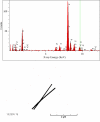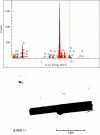Presence of tungsten-containing fibers in tungsten refining and manufacturing processes
- PMID: 19126624
- PMCID: PMC2721673
- DOI: 10.1093/annhyg/men078
Presence of tungsten-containing fibers in tungsten refining and manufacturing processes
Abstract
In tungsten refining and manufacturing processes, a series of tungsten oxides are typically formed as intermediates in the production of tungsten powder. The present study was conducted to characterize airborne tungsten-containing fiber dimensions, elemental composition and concentrations in the US tungsten refining and manufacturing industry. During the course of normal employee work activities, seven personal breathing zone and 62 area air samples were collected and analyzed using National Institute for Occupational Safety and Health (NIOSH) fiber sampling and counting methods to determine dimensions, composition and airborne concentrations of fibers. Mixed models were used to identify relationships between potential determinants and airborne fiber concentrations. Results from transmission electron microscopy analyses indicated that airborne fibers with length >0.5 microm, diameter >0.01 microm and aspect ratios > or =3:1 were present on 35 of the 69 air samples collected. Overall, the airborne fibers detected had a geometric mean length approximately 3 microm and diameter approximately 0.3 microm. Ninety-seven percent of the airborne fibers identified were in the thoracic fraction (i.e. aerodynamic diameter < or = 10 microm). Energy dispersive X-ray spectrometry results indicated that airborne fibers prior to the carburization process consisted primarily of tungsten and oxygen, with other elements being detected in trace quantities. Based on NIOSH fiber counting 'B' rules (length > 5 microm, diameter < 3 microm and aspect ratio > or = 5:1), airborne fiber concentrations ranged from below the limit of detection to 0.085 fibers cm(-3), with calcining being associated with the highest airborne concentrations. The mixed model procedure indicated that process temperature had a marginally significant relationship to airborne fiber concentration. This finding was expected since heated processes such as calcining created the highest airborne fiber concentrations. The finding of airborne tungsten-containing fibers in this occupational setting needs to be confirmed in similar settings and demonstrates the need to obtain information on the durability and associated health effects of these fibers.
Figures
References
-
- Agency for Toxic Substances and Disease Registry. Toxicological profile for tungsten. Atlanta, GA: ATSDR; 2005. - PubMed
-
- American Conference of Governmental Industrial Hygienists. Threshold limit values for chemical substances and physical agents and biological exposure indices. Cincinnati, OH: ACGIH; 2007.
-
- Baron PA. Application of the thoracic sampling definition to fiber measurement. Am Ind Hyg Assoc J. 1996;57:820–4. - PubMed
-
- Finkelstein MM, Verma DK. Exposure estimation in the presence of nondetectable values: another look. Am Ind Hyg Assoc J. 2001;62:195–8. - PubMed
-
- Griffiths WD, Vaughan NP. The aerodynamic behaviour of cylindrical and spheroidal particles when settling under gravity. J Aerosol Sci. 1986;17:53–65.




